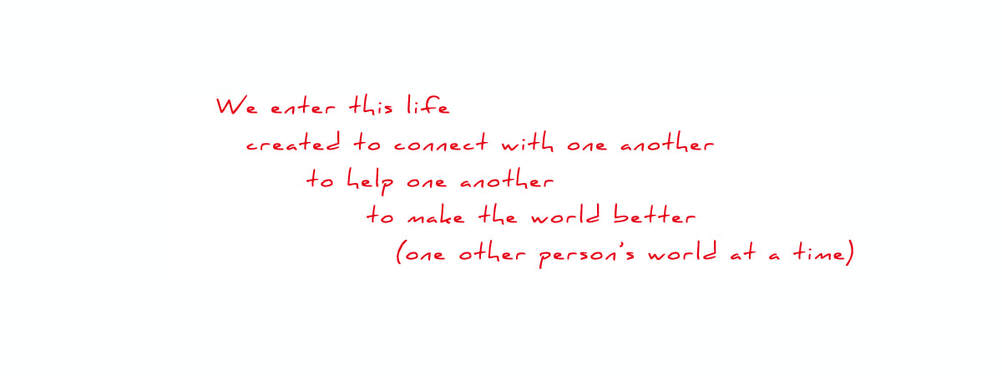|
Journeys must start somewhere. A nonprofit director faced a difficult donor conversation, unsure if the person would continue to give. She sought advice on how to handle the meeting and heard: “No matter which way it goes, say thank you. Thank you for continuing your support or Thank you for supporting us for many years.” She felt relief like a cool breeze, then dialed the phone. A thousand miles away, a man interviewed for a promotion and awaited the outcome. He felt anxious about how to handle the call and asked for suggestions. “Either way say thank you; for the new job or for the opportunity to receive consideration.” Another cool breeze blew. Saying “Thank you” shows gratitude. And gratitude is a key indicator of joy. And joy is not determined by circumstances -- if a donation happens or a job offer materializes -- or any other winds of change that blow your way. Our world needs more joy, deep joy. Does it really start by saying thank you? Yes, according to ancient wisdom: “For the mouth speaks what the heart is full of.” ©Copyright 2021, David Staal, all rights reserved
0 Comments
During pre-trip prep, a whitewater rafting guide shared important reminders about listening, bouncing off rocks, and paddling. He also shared priceless wisdom. “Your job is to do what I say right away,” he said. “When I yell ‘hard forward,’ then really dig in. If you hear ‘back,’ then paddle like we’re going in reverse. Anyone know why we will do that?” “Because you tell us to?” said someone attempting humor. The guide ignored the comment. “We need to control our speed. The only way to navigate is to make our raft go faster than the water or slower than the water. When we go the same speed as the current, we go wherever the river wants to take us.” Those words proved invaluable to pilot a class 5 river -- and to navigate life. Go the same speed as everyone around you, and you go wherever the crowd takes you. Prepare to hit rocks. Figure out how and when to dig in or slow down, though, and the journey turns exhilarating. Your choice. ©Copyright 2021, David Staal, all rights reserved
©Copyright 2021, David Staal, all rights reserved
Two leaders, a decade apart, shared words that 1) built my integrity as a spokesperson and 2) lowered my blood pressure.
What did they say? The first advice came while preparing for a press briefing in response to unwanted and distorted publicity. I commented that with the right spin, we could sway the media to our angle. After a quick, biting comment about that approach, I heard a better game plan: “Worry less about how things look and focus more on how things really are.” The second piece of golden counsel dealt with a much different circumstance. Less than a year into running an organization, I called our board chair to announce bad news. A dark financial report caused me to panic, which proved easy for him to discern. His response provided the calm I needed: “Situations are rarely as good as they seem or as bad as they seem.” Neither person gave me a solution. Instead, they shared something timeless and priceless -- the freedom that comes from embracing reality. Nearly a modern edition of the ancient wisdom: “Fix your thoughts on what is true, and honorable, and right, and pure, and lovely, and admirable.” ©Copyright 2021, David Staal, all rights reserved A friend purchased his dad’s graphic design studio and it’s now a premier creative agency. Our working relationship and friendship began in the analog world of brochures and, over a couple decades, has continued into the digital world where they provide innovative leadership.
Along the way, he’s remodeled their building multiple times. Unassuming from the outside, it’s a digital Disneyland inside. On a tour of the facility, he unlocked the door to a small room in the basement. As the lights turned on, so did his smile. “This,” he said, “is where I come to think and gain clarity.” Gesturing to the large layout table, graphic designer utensils, pivoting desk lamps, and backless stools, he explained that the room held the original tools of the trade his dad used in the studio’s early days. “I love this space because it reminds me of where we’ve been.” Did I mention that he owns a premier firm and has figured out how to also partner with organizations that improve the world? My friend has a humble, grounded view of true success. That brief moment breathing in his firm’s history delivered a timeless lesson; respect the past in order to inform perspective about the road ahead. So many answers for today’s challenges already exist for those willing to revisit experience -- their own or that of others. Such a simple journey could start with esteem for ancient wisdom: “For what does it profit a man to gain the world and lose his soul?” ©Copyright 2021, David Staal, all rights reserved Many years ago, I received an offer to shift roles that sounded exciting until I learned the new job meant I no longer had a large team to lead. Popular wisdom says: “If you think you’re leading, but no one is following, then you’re only taking a walk.”
Our organization’s president offered a different perspective. “This role will require you to learn how to lead by influence and what it really means to serve people. You’ll become a more effective leader because most people can only lead by authority,” he said. “Take away their position, though, and often no one will choose to follow them. That’s not leadership; it’s hierarchy.” I took the role. Fortunately, the president provided ongoing, nearly real-time mentoring; he proved surprisingly generous with his time. Years later, he made a recommendation that landed me in a CEO role at a different organization. “You’re ready,” he said. Today, he leads one of our country’s largest nonprofit organizations, and his people there love him as their leader for the right reasons. I still do, too. What a great example of better, enduring wisdom: “Whoever wants to be a leader among you must be your servant.” It’s hiring and annual review season. Experience has taught that although words enter my ears, I need not let every one of them establish residency.
22 years ago, a person agreed to approve my hire despite two reservations: 1) She said I didn’t have what it takes to serve as the organization’s voice, and 2) determined I had no writing skills. Years later, another leader decided to appoint me as local/national media spokesperson during a very turbulent PR season. A few years after that, a different leader asked me to co-author a book – the first of several published. Clearly, authority and wisdom can travel on separate itineraries. In a world overflowing with opinion, experience has shown that these words point to a better way: "Guard your heart above all else, for it determines the course of your life." Simple messages can make profound differences.
Duke University’s legendary basketball coach, Mike Kryzyzewski, is a big fan of the statement I believe in you. He says, “Those four words can mean the difference between a fear of failure and the courage to try.” Tell your child I believe in you as many times, and in as many ways, as you can. Every kid needs to feel accepted and valued. He constantly wonders about himself and wrestles with competing self-perceptions—his abilities versus his inabilities. Ideally, the people closest to him will help tip the scales in this internal battle. The thought process works something like this: “My dad believes in me—so I should believe in myself.” A child propped up by such confidence will face the inevitable challenges of life with resolve. Such was the case with Wilma Rudolph. Early in life, doctors told her mother that, due to a debilitating disease, Wilma might not walk again. Wilma decided to embrace a different prognosis. “My mother told me I would, so I believed my mother.” And that belief became the foundation that later enabled her to become a U.S. Olympic Gold Medalist in the 100, 200, and 400 (relay) meter races. One of my favorite illustrations of this principle comes from Ben Zander, conductor of Boston Philharmonic Orchestra and a professor at the New England Conservatory of Music. He believes grand potential is released when belief replaces reasons for self-doubt, which is why he gives all his students the grade of “A” at the beginning of the course. Their first assignment is to write him a letter, dated at the end of the term, which explains the story of what the student will have done to earn this high mark. His philosophy: “This A is not an expectation to live up to, but a possibility to live into.” Give your child an A and watch him or her live into the possibilities you’ve inspired. This topic came up one day over lunch with my friend and mentor Dick. I asked him what advice he had for me about raising a teenager—after all, my son’s thirteenth birthday was quickly approaching, and I’ve heard that parenting challenges change when the teen years arrive. “Expect the best from him, and tell him that you do,” Dick said. “Then watch him chase it to make it happen.” Then Dick got more specific. “For instance, many parents joke about how awful they expect their children to be as drivers. Your son as a driver might seem a long way off, but it’s not. So instead of making light of him, take any opportunity you have to tell your son that you believe he’ll make an excellent driver some day, and give him a reason or two why. Take that same logic about predicting his success and apply it to as many situations as you can.” Nobel Prize winning author Toni Morrison says, “Long before I was a success, my parents made me feel like I could be one.” Her observation is a powerful one—and one we can put to use with kids of all ages. Many of our country’s incredible educators know how to inspire life-changing confidence. We can learn (and apply) lessons from how they share simple messages that make profound differences. Let’s start with a Kindergarten teacher in Indiana, who begins class every day with a three-statement, repeat-after-me exercise: “I am kind.” “I am smart.” “And I am brave.” Can words really make such a big difference? Yes. Pastor and author Jack Hayford tells us why: “It is perhaps among the most humbling features of God’s ways with humankind that He confers upon us a staggering degree of power (and responsibility) in the capacity of our words to cause things to happen.” Our world desperately needs more kind, smart, and brave people. So, what words will you tell your children? *Portions of this column come from David’s book, Words Kids Need to Hear © 2021 David Staal. All rights reserved. davidstaal.net  You likely know someone who lost a job. Someday his or her unemployment will end, and a new job will begin – but not soon enough. Four Corners of Grace will help that person make the hard journey from today to “someday.” This new book strengthens the heart and provides reason for hope. It’s a fast read, and the impact is immediate. Your friend or colleague will thank you for sharing a source of fresh, life-giving perspective. Or maybe it’s for you. |
AuthorDavid Staal writes, speaks, consults, and has filled a career with executive and leadership positions Blogs/Articles |












 RSS Feed
RSS Feed